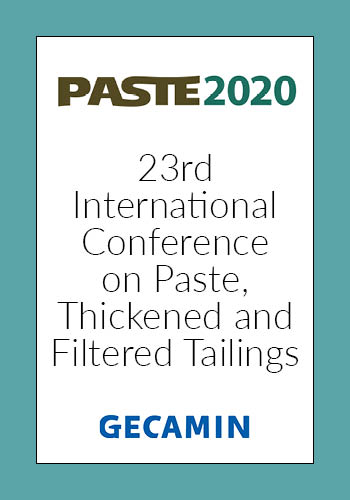Sandy Tailing Transport between Thickener and Filtration - Case Study

|
Authors: Silva, M; Marques, R |
DOI https://doi.org/10.36487/ACG_repo/2052_85
Cite As:
Silva, M & Marques, R 2020, 'Sandy Tailing Transport between Thickener and Filtration - Case Study', in H Quelopana (ed.), Paste 2020: 23rd International Conference on Paste, Thickened and Filtered Tailings, Gecamin Publications, Santiago, https://doi.org/10.36487/ACG_repo/2052_85
Abstract:
There is an increasing trend in iron ore mining in Brazil regarding the disposal and treatment of sandy tailings from concentration processes by reverse cationic flotation techniques. Filtering and later disposal of sandy tailings in piles known as PDR (Tailings Disposal Pile) has been shown to be a rising method to the detriment of known tailings dams. In the case study in question, the tailings thickening operation is too far from the filtration and stacking point, so it was necessary to consider a material transport mode between the two operations (Thickening and Filtration), which was the tailings pipeline. The pipeline is 6.7 km long tail and 52.0 m static lift designed to operate with process variations especially in terms of percent solids and variations in the beneficiation plant rate. The drive consists of five centrifugal pumps with 600 HP motors and the piping follows the ANSI B36.10 dimensional standard and the API 5L Grade B material standard with 16 inch diameter. To support the pipeline sizing a fundamental step was to perform the characterization of the material to be transported. Several tests were performed of granulometry, rheology, abrasiveness, solids density, slurry corrosivity, inclination angle of the pipeline, among others. The results of the tests were used to calibrate the mathematical models. The pipeline was evaluated considering the steady-state and transient flow regime. The results of the steady-state analysis made it possible to specify the quantity and model of the pumps, as well as to evaluate the velocities and pressure losses. The transient analysis, however, was performed to identify the operating scenarios that lead to the highest pressures and thus confirm the characteristics of the pipelines and consider the necessary hydraulic protections.
References:
ALVES, M.S. BARBOSA, R.A. (2019) ‘Characterization of minerals Slurries for duct Transportation, Rio Pipeline Conference and Exhibition 2019 – Held between 03 and 05 September, in Rio de Janeiro), IBP, Rio de Janeiro, 8 pages.
MIEDEMA, S.A. (2016) Slurry Transport – Fundamental &, A Historical Overview & The Delft Head Loss & Limite Deposit velocity framework , SA Miedema / Delft University of Tecnology, Delft, the Netherlands.
© Copyright 2025, Australian Centre for Geomechanics (ACG), The University of Western Australia. All rights reserved.
View copyright/legal information
Please direct any queries or error reports to repository-acg@uwa.edu.au
View copyright/legal information
Please direct any queries or error reports to repository-acg@uwa.edu.au